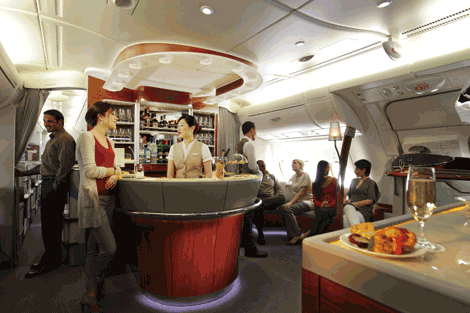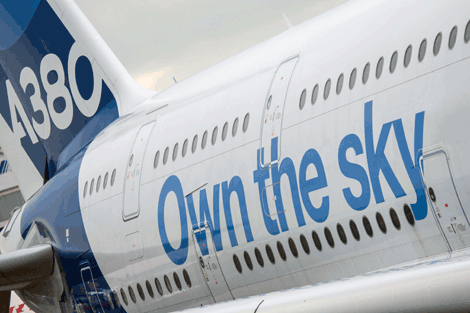
With the arrival of the B747 in the 1970s, a new era in long-distance air travel dawned. Dubbed “The Jumbo Jet”, the B747 was the first passenger aircraft to offer seating on two separate decks – it was a sensation at the time. Boeing held the monopoly in the very large aircraft segment thereafter, and had little competition from rival Airbus for almost two decades.
Inspired by the Jumbo’s success and becoming increasingly recognised in the global aircraft manufacturing industry, Airbus announced plans to design its own multi-story aircraft in 1994 – project A3XX began. It was developed to meet rapidly growing global air passenger demand, and to provide relief to the increasingly congested hub airports of the world. But it also set one objective to distinguish itself markedly from the competition: the A380 was to undercut the B747’s fuel consumption by a staggering 25 per cent.
A game-changer lands
In 2000, Airbus initiated its €8.8 billion (US$12 billion) programme to build the iconic aircraft, having secured 50 firm orders from six launch customers. When the first A380 was delivered to launch carrier Singapore Airlines (SIA) in October 2007, the programme was years behind schedule and billions of euros over budget. The A380 was in desperate need of success.
When SQ380 took off from Singapore’s Changi Airport for Sydney, the world was in awe. The aircraft is able to seat 525 passengers in a typical three-class configuration, or up to 853 in an all-economy set up. The A380 has a range of 15,700 km, sufficient to fly nonstop from Dubai to Los Angeles, or Hong Kong to New York.
On top of this, it is a gorgeous aircraft, and offers previously unknown luxuries. First class passengers could for the first time indulge in utmost comfort and privacy in personal onboard suites – a true novelty in commercial aviation at the time. Business and economy class passengers enjoyed an abundance of space, given the A380’s 50 per cent increase in cabin area, wider seats, larger windows and 60cm extra headroom versus the B747-400.

Nowadays, bars and lounge areas are available in virtually all A380 first and business classes, regardless of operating airline. Emirates takes it one step further: its first class cabin on the A380 boasts two luxurious spa showers. Korean Air’s superjumbos feature a duty-free shopping area at the aft of the plane, and Air France adorns its A380 upper deck with a digital art gallery. In short: in 2007, a legend was born.
Signs of success
The A380 model is in service today with ten operators. Emirates is the by far the largest operator of the superjumbo, with 44 aircraft already in service. It is also the UAE-based carrier that has given the A380 its biggest boost so far, when it announced at last November’s Dubai Air Show that it signed a deal with Airbus for the delivery of 90 more A380s through to, or up until 2025, making it the biggest single deal for the world‘s largest commercial jetliner. Emirates chief executive officer Tim Clark expressed the airline’s satisfaction with the A380, saying it performed “better than both the airline and Airbus had anticipated”. Emirates said the newly ordered aircraft will serve both replacement and growth purposes.
Other sizeable operators of the model are SIA and Qantas, which operate a fleet of 19 and 12 A380s respectively. Both these airlines have five or more superjumbos on order at the moment.
But the runway to success, in this case, has had to be modified to allow the aircraft type to reach its full potential.
Accommodating supersize
Production of the world’s largest commercial airliner proved a logistics challenge for Airbus. The manufacturer had to devise thereunto untested ways to collect all individual sections of the aircraft produced in France, Germany, Spain and the UK, and transfer them to the final assembly point. To be able to move the massive fuselage and wing sections, Airbus developed a fleet of roll-on ships and barges, port facilities and new or modified roads.
An aircraft of this size and dimension not only challenged Airbus’ creativity and resource-fulness; airport operators around the world also faced a myriad of impediments hosting the A380. Runways and taxiways needed strengthening and extending. New multi-storey passenger bridges had to be designed and installed to cope with the logistics of boarding and disembarking an average of 520 passengers in short turnaround cycles. Working on two full-size passenger decks also created challenges for catering, cleaning and cargo crews.
After six years of continuous A380 operations, some airports are still unable to accommodate the aircraft. While Perth Airport only recently received clearance for superjumbo operations, Jakarta’s Soekarno-Hatta airport (CGK) is still masterminding the extension of its runways. Being one of Asia’s busiest airports, and certainly one of the fastest growing, CGK is working feverishly to complete the extension. Emirates has already indicated interest in sending the A380 to the Indonesian capital.
And airport operators are well advised to up their ante and reconfigure their concourses if they want to remain competitive. The A380 is here to stay for the foreseeable future. Emirates’ Dubai Air Show 90-strong top-up order fortified this. Furthermore, the fact that the Emirates orders will be delivered up until 2025 ensures that the A380 production line will remain open until then, if not longer.
Utilising the beast
Some A380 customers have had trouble filling the cabins of the superjumbo, and have had to resort to rostering the double-deckers on regional feeder routes. Emirates, however, fares well using the aircraft on long- and medium-haul point-to-point services.

Efficiency is the key word in Emirates’ superjumbo operations, said Clark: “The A380 fleet is a reflection of Emirates’ commitment to increase efficiency on major routes around the world”. Emirates expanded its A380 services to Europe, Australia, Mauritius and the United States last year. The aircraft will also be used to boost services to Barcelona and London Gatwick this year and superjumbo services to Zurich already commenced in early 2014. “More routes are to be announced over the course of this year,” Clark added.
But why is the A380 checking all the boxes for Emirates, but not for other airlines? The answer to this question is manifold. It has a lot to do with geography. Dubai is almost perfectly located in the middle of the world’s major landmasses, rendering it an ideal transfer hub for East-to-West and North-to-South air traffic. It is precisely these markets in the East and the South that continue to be the fastest-growing economies less affected by the economic or social crises experienced in the developed world over the past decade. Add to this a daring management team with bold growth strategies, a supportive Emirati government and plenty of room for airport expansion, and you’ve got a winning formula.
Some industry rivals might think Emirates is taking a huge risk, but Clark is not deterred. “If you have got a global operation and you’re flying to places like Houston, each of those Houston frequencies is 2.5 aircraft a day in order to maintain a daily service from Dubai,” Clark recently told Bloomberg. If you also consider Emirates’ twice daily A380 frequencies to both Sydney and Melbourne, one soon realises where all these additional aircraft are going.
Other operators have not had it so easy with the A380 and had to admit that the aircraft may simply be too large for their networks in today’s fiercely competitive markets. China Southern Airlines, for example, employs the A380 on mostly domestic rush hour flights from its home base in Guangzhou to Beijing and Shanghai. It upgraded its daily non-stop Guangzhou-Sydney service to the A380 only last October, but recently announced that it will replace the superjumbo with the much smaller A330 on the route from February due to poor passenger load. Once the A380 is off the Sydney rotation, Los Angeles will be the only international A380 destination served by China Southern.
When Malaysia Airlines (MAS) first ordered the aircraft some 12 years ago, the markets were different. Competition from Middle East carriers was not as strong as it is today, and did not cut into Asian carriers’ traffic figures on European routes as much as it currently does. MAS has since had to invent new ways to utilise its superjumbos with the greatest possible efficiency. In addition to MAS’ daily services from Kuala Lumpur to London and Paris, the A380 is deployed on the daily rotation connecting the Malaysian capital with Hong Kong.
While MAS’ original plans of flying the A380 to most of their European and US destinations have not materialised, the airline is still satisfied with the aircraft’s performance, praising above all its fuel-efficiency. “The A380s have been successful with passenger load factors of above 80 per cent, sometimes even full load,” group chief executive officer Ahmad Jauhari Yahya said. “We have been flying the A380s aggressively, 17 hours a day [and] may order a few more.” This may be, however, a response to competitor SIA’s recent A380 top-up order.
Thai Airways (THAI) is another Asian A380 operator that has seen its Asia-Europe market share dwindle over the decade since it placed its first superjumbo order. The Bangkok-based carrier axed the A380 from its London Heathrow service before the inaugural flight. Instead, THAI now flies the superjumbo on shorter routes to Tokyo and Osaka, which might seem like a waste. But again, it is market demand that dictates where companies put their resources.
In the case of THAI and the A380, a strong Japanese Yen sees base air fares from Bangkok to Tokyo almost on par with fares from Bangkok to London, despite the latter being roughly twice the distance, and burning twice the fuel. Add to that a still-weakened Japan Airlines and no competition from the Gulf carriers on the route and you have a recipe for successful A380 utilisation.
Jumbo size does not fit all
On the face of it, the giant double decker appears to be working better for some Asian carriers than for others. The Gulf carriers, spearheaded by Emirates, benefit greatly from their strategic location that allows them to offer point-to-point services almost anywhere. As the airlines of the Middle East are generally still very young (Emirates is 29, Qatar Airways is 21 and Etihad is 11 years old), their networks are expanding rapidly, and they are opening up many new destinations at a high frequency. The A380 is an ideal aircraft for such a strategy, offering the greatest number of seats on a route that is then served once a day to connect it, through Dubai, to the rest of the world.
Hong Kong’s home carrier and industry veteran Cathay Pacific follows a different approach. The airline does not currently operate A380s, and do not have any on order. A spokesperson maintains that it is the airline’s strategy “to offer global connectivity and multiple flight frequencies on trunk routes for maximum schedule flexibility to passengers.”
On the horizon
Six years of the A380, however, have changed the face of aviation. The superjumbo has become the benchmark in the very large aircraft segment. It has given passengers new perspectives on travel – across all classes – that will need to be exceeded whenever Airbus or Boeing roll out their next models. This is a great development for us – the passengers – as we will see the most benefits. Emirates’ top-up order signals that the A380 programme is anything but dead.

More positive news travels to us from China and India: until recently both countries only allowed for tightly controlled operations of the double decker, or banned the aircraft entirely. However, for over a year now China has deregulated A380 operation rights in its airspace, immediately prompting German flag carrier Lufthansa to boost its superjumbo frequencies to Beijing and Shanghai to daily, as well as enabling Air France to “supersize” its three weekly flights between Paris and Shanghai.
Many airports across India, including the capital New Delhi and the financial hub Mumbai, have undergone renovation and runway extensions that can accommodate the A380. The New Delhi airport added three gates specifically meant for the plane. A380 operators Emirates and Lufthansa have been struggling for years to obtain A380 landing rights into what they consider the A380 market of the future. The struggle seems to have finally come to an end earlier this year when the Indian government announced that it has lifted restrictions that had thus far prohibited foreign airlines from deploying the A380 on routes to the country’s airports. It is no surprise that Emirates and Lufthansa were the first two airlines to embrace this move and announce A380 operations to India for later this year.
This is a potentially huge boost to the A380 programme, as all current major operators have declared strong interest in flying the aircraft type into these high-traffic markets of the future. And with airports around the world investing billions in making way for the A380, and air passenger traffic set to continually rise, it looks as though the full impact of the superjumbo on the aviation landscape is yet to be witnessed.
A380 Order Log
Total orders 304
Total deliveries 122
Aircraft in operation 122
Number of operators 10
Number of customers 19
* Summary as of December 31, 2013












